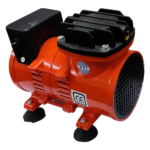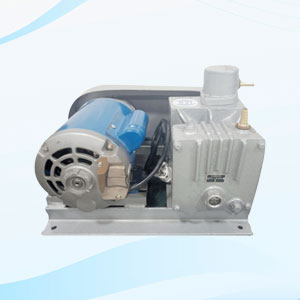Oil Seal High Vacuum Pump
This model is rotary sliding vane type, having four special steel vanes. It is recommended for handling dry and clean air. It is designed as a compact unit with built in inlet air filter and oil baffle cum silencer. A vacuum feed lubrication system positively supplies sufficient quantity of oil to all working parts. The oil mixed with the exhaust air is baffled, separated and is returned back to the oil chamber by pressure of the air, thus reducing the oil consumption to minimum and also avoiding pollution of atmosphere with oil vapour to some extent.
Specifications:
- Displacement:150 Lit / Min 1440 RPM
- Maximum Vacuum:28″Hg
- Operating Vacuum Range:2″ Hg to 28″Hg
- Standard Speed:1440RPM
- Speed Range:1200 to 1750 RPM
- Working Temp:85°C
- H.P.Required:½ H.P.at 1440 RPM
- Rating:Continuous
Application for use as Vacuum Pump:
- Laboratories
- Pollution control equipments
- Material handling equipments
- Labeling machines
- Disordering station
- Glass forming
- Medical instruments Dentists
- Chemical analysers
- Gas charging in A/c
- Suction machines
- Photographic developing machines
An Oil Seal High Vacuum Pump is a type of vacuum pump designed to generate high vacuum levels while utilizing oil as a sealing and lubricating medium. Here’s an overview of its operation and characteristics:
Vacuum Generation: Oil seal high vacuum pumps operate on the principle of positive displacement, typically using a rotary vane or rotary piston mechanism. These pumps can achieve relatively high vacuum levels, often in the range of 10^-3 to 10^-6 torr or even lower.
Oil Sealing: Unlike dry pumps that rely on clearance seals or other sealing mechanisms, oil seal high vacuum pumps utilize oil as both a sealing and lubricating medium. The pump chamber is partially filled with oil, which creates a dynamic seal around the moving parts, preventing gas from leaking back into the evacuated chamber.
Lubrication: In addition to providing a seal, the oil in these pumps also serves as a lubricant for the moving parts, reducing friction and wear. This lubrication helps maintain the pump’s efficiency and longevity.
Operation: The pump’s mechanism, whether rotary vane or rotary piston, operates within the oil-filled chamber. As the mechanism rotates or reciprocates, gas is drawn into the pump chamber and compressed, ultimately being expelled through an exhaust port. The oil captures any contaminants or condensable vapors present in the pumped gas, helping to maintain the vacuum level.
Applications: Oil seal high vacuum pumps are commonly used in applications where a clean and reliable vacuum is required, such as in vacuum distillation, thin film deposition, freeze drying, and high vacuum systems in research laboratories and industrial settings.
Maintenance: Maintenance of oil seal high vacuum pumps typically involves regular checks and replacements of the sealing and lubricating oil, inspection of seals and gaskets for wear, and cleaning of pump components. Proper maintenance is crucial to ensure optimal performance and prevent contamination of the vacuum environment.
Considerations: While oil seal high vacuum pumps offer excellent performance and reliability, they may not be suitable for applications where contamination by oil vapor is a concern. In such cases, dry pumps or oil-free vacuum pump technologies may be preferred.
Overall, oil seal high vacuum pumps are widely used for their ability to generate high vacuum levels reliably and efficiently, making them essential tools in various scientific, industrial, and research applications.
Services Area
- Ahmedabad |
- Ankleshwar |
- Baroda |
- Dudhrej |
- Gujarat |
- Rajkot |
- Surat |
- Bengaluru |
- Chennai |
- Delhi |
- Faridabad |
- Hyderabad |
- Kolkata |
- Maharashtra |
- Bangalore |
- Mumbai |
- Nashik |
- Navi Mumbai |
- Pune |
- Thane |
- Ulhasnagar |


